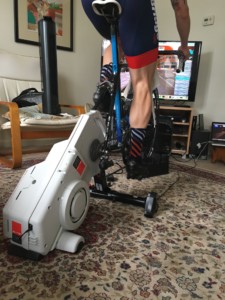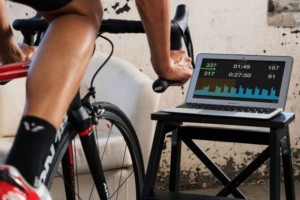Whether it's escaping the weather as winter sets in or grabbing a quick hour workout, the indoor trainer is a valuable tool in any cyclist's arsenal. It can be mind-numbingly boring though. That doesn't mean that it can't be one of the most valuable training modalities available to you.
In this episode of the Tailwind Coaching Podcast, I'll show you why the trainer is such a valuable tool. I'll also give you a few of my favorite workouts and interval progressions. These won't just get you fit: they'll keep you motivated to get on the trainer again and build even more fitness. And the variety they offer will help you round out your fitness and get you strong and confident when you get back out on the road.
So click through the jump and learn how you can get the most out of your indoor cycling training.
Podcast: Play in new window | Download (Duration: 36:03 — 25.7MB)
Subscribe: RSS
 The Appeal of Indoor Cycling Training
The Appeal of Indoor Cycling Training
Indoor cycling training is one of those things that most people don't really like. Staring at a wall while you pedal away on a trainer can be mind-numbing. But it can also be one of the best training modalities available to a cyclist, no matter the weather. Let's explore how the trainer can significantly boost your fitness.
Controlling your environment
The nice thing about indoor training is your ability to control nearly everything. Temperature, trainer resistance, humidity, airflow….all these things can be precisely controlled. You have every ability to make your training space as consistent as possible. This has a huge benefit of removing the environment as a factor in your workouts. Basically, if your legs feel crappy, it's because they do. It's not because of the heat, or humidity or any other factor.
To this end, you'll want to have consistent control of the temperature in your training space. This might mean a heater or some air conditioning. A fan is always good to facilitate evaporative cooling on your body and keep you from overheating. When it comes to training, keep a log of your trainer resistance and set it to match previous workouts that are similar to the one you're doing now.
Not only do you have the ability to control your environment in terms of temperature, but you can also control airflow with fans. The addition of evaporative cooling will decrease overheating and create an experience more like an outdoor ride. The larger the fan, generally the better the cooling and the better performance you can sustain.
Finally, you can very specifically control the resistance of your trainer. Because you're not tied to wind resistance or outdoor terrain, you can repeat intervals with great specificity.
Increased specificity
One of the biggest benefits of training indoors is the ability to precisely plan your workouts. You can really drill down into specific intervals and durations. For example, while you can do VO2 max intervals outdoors, you'll always have some variability in the intensity and duration. Outdoors, you'll have to find terrain that allows you to do an interval approximately the right length and intensity.
As an example, you'll probably find a climb that allows you to do 3ish minute VO2 intervals. You'll also have to shoot for an average power number, ignoring your VI. On a trainer, you can specify 3 minutes on the dot with intensity and VI as even as your legs will allow. In terms of physiology, you'll get more specific training this way.
You can also find value indoors by eliminating a lot of the extra “junk” time in between intervals. Because you're intensely controlling your workouts, you'll condense a potentially long ride into a very concentrated workout. (Imagine riding outside: going from climb to climb takes time and miles can add up. Indoors you select intervals and rest and then just execute) This is doubly true when using things like the Zwift Workout builder.
Using a tool like that you can build a hard, efficient workout into just an hour. The same workout, performed outside, could take twice that time.
 Intervals to help you make the most out of your indoor cycling training
Intervals to help you make the most out of your indoor cycling training
Because it's so specific, indoor training needs quite a bit of direction. Simply jumping on the trainer and noodling along won't get you very far. With that in mind, here are a few of my favorite workouts to help you make the most out of your indoor training time.
Sweet Spot Special
Sweet spot training is just that: the sweet spot in your physiology. You can perform a lot of this training without burning yourself out, which is great for indoor training. In addition, one of my favorite things about sweet spot training is how adaptive it can be. You can use it as a workout in itself or use it as the base for any number of crazy ideas.
For example, let's look at the 2×20 concept. In this case, you'll perform two 20-minute intervals at around 91% of your threshold with about 8 minutes rest in between. You can do straight sweet spot training or you can mix it up a little bit. Changing cadence, gearing, standing and sitting in the drops are all good ways to add variety to your sweet spot training.
Cycling Fundamentals
Cycling fundamentals are things like leg speed and neuromuscular skills. Your ultimate goal is to improve your efficiency to decrease the amount of energy needed to maintain the same speed. Perhaps one of the greatest benefits of training indoors on a trainer is the ability to do tons of neuromuscular work. Combining super spin work, single leg drills, low cadence control work (low cadence, low gears, controlling tension around the pedal stroke) and standing drills can give you significant improvements in your efficiency on the bike.
These kinds of workouts are perfect for a recovery day or a day between high-intensity workouts. You can also stick all kinds of fundamentals into and between endurance blocks. As I mentioned above, if you want to get more out of your sweet spot day, build some fundamentals into your intervals to double up on your training.
 High Intensity Interval Training
High Intensity Interval Training
I've talked a lot in the past about high intensity interval training. In fact, I've built hundreds of training programs based on high intensity interval work. The fact is indoor training is the perfect place to execute interval training days. The amount of control you have over intensity, duration and the environment make these intervals repeatable and very specific.
My favorite kinds of high intensity intervals are the repeatable intervals. 9×3 minute VO2 max intervals, 5×5 minute VO2 max intervals, 3×8 minute VO2 max intervals, Tabata type intervals, and sprint intervals are some of the choices for short duration interval training.
To add more value to your high intensity training, consider throwing some neuromuscular training into your intervals. Turn those 3 minute VO2 intervals into climbing endurance intervals. Make your Tabata type intervals into neuromuscular training by using your cadence to ramp up the intensity.
Take your indoor training outdoors
It's worth saying that indoor training is one of the best values for your training time around. However, you still need to take your training outside onto real roads. Once you've spent some time on the trainer learning to handle a variety of intervals, you can easily take your training outside and apply those concepts to your regular routes.
The fitness you build indoors will translate outside easily. Just remember, outside is never as specific or as controllable as indoors.
